
Carex abrupta is a species of sedge known by the common name abrupt-beaked sedge or abruptbeak sedge. It is native to the western United States from California to Idaho, where it grows in moist mountain habitat such as meadows.
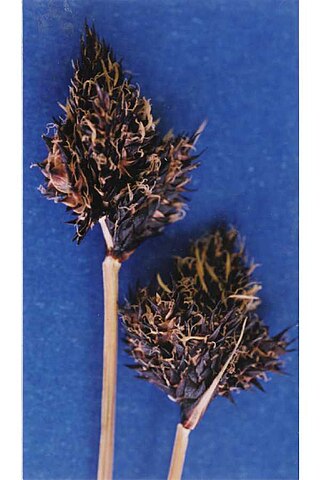
Carex albonigra is a species of sedge known by the common name black and white sedge. It is native to western North America from Alaska and most of western Canada to California to New Mexico, where it grows in mainly dry, rocky high mountain habitat such as talus. This sedge forms a dense clump 10 to 30 centimeters in height with narrow gray-green leaves. The inflorescence is a headlike cluster of overlapping spikes. The fruit is coated in a sac called a perigynium which is dark purple to chestnut brown and often tipped with white.

Carex comosa is a species of sedge known as longhair sedge and bristly sedge. It is native to North America, where it grows in western and eastern regions of Canada and the United States, and parts of Mexico. It grows in wet places, including meadows and many types of wetlands. Tolerates deeper water than most common species and is good for retention basins. This sedge produces clumps of triangular stems up to 100 or 120 centimeters tall from short rhizomes. The inflorescence is up to 35 centimeters long and has a long bract which is longer than the spikes. It is a cluster of several cylindrical spikes. The scales over the fruits taper into long, thin awns.

Carex diandra is a species of sedge known by the common names lesser tussock-sedge and lesser panicled sedge.
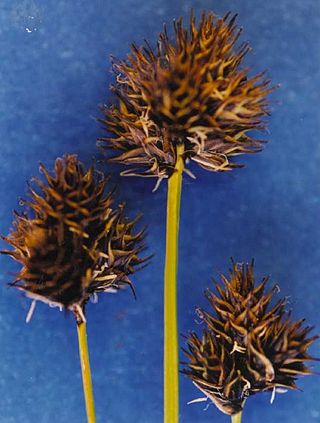
Carex haydeniana is a species of sedge known by the common name cloud sedge.

Carex illota is a species of sedge known by the common name sheep sedge. It is native to western North America, where it grows in wet places such as marshes and mountain meadows, from New Mexico and California north to Western Canada.

Carex mertensii is a species of sedge known by the common name Mertens' sedge. It is native to western North America from Alaska to California to Montana, where it grows in moist and wet habitat in mountain forests and meadows. This sedge produces clumps of stems reaching maximum heights between 80 and 120 centimeters. The leaves are small; those toward the bases of the stems are reduced to sheaths only. The inflorescence is a densely packed, bullet shaped cluster of overlapping flowers, mainly hanging on long peduncles. Each inflorescence is generally 2 to 4 centimeters long. Each of the flowers has a dark-colored bract.

Carex obnupta is a species of sedge known by the common name slough sedge. It is native to western North America from British Columbia to California where it grows abundantly in wet, often saline habitat such as wetlands. The plant produces upright, angled stems approaching 1.2 meters in maximum height, growing in beds or colonies from rhizome networks. The inflorescence is a cluster of flower spikes accompanied by a long leaflike bract. The pistillate spikes and sometimes the staminate spikes dangle on peduncles. The fruit is coated by a hard, tough, shiny perigynium which is generally dark in color.
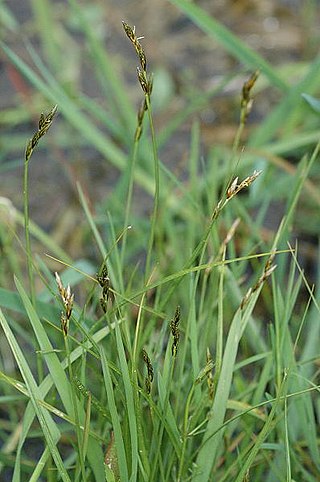
Carex leporina is a species of sedge known in the British Isles as oval sedge and in North America as eggbract sedge. It is native to Eurasia and eastern and western North America, where it grows in seasonally wet habitat, such as meadows and fields. This sedge produces many thin stems and narrow leaves. The inflorescence is an open cluster of several flower spikes. The pistillate flower has a reddish or brownish bract with a gold center and white tip.
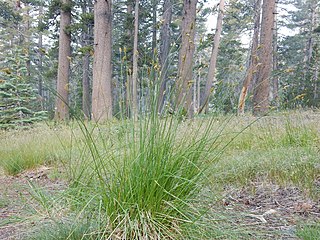
Carex pachystachya is a species of sedge known by the common name Chamisso sedge.

Carex pansa is a species of sedge known by the common name sand dune sedge. It is native to coast of western North America from British Columbia to California, where it grows in dunes and other sandy habitat. This grasslike sedge produces sharply triangular stems up to about 40 centimeters tall from a network of thin, long, coarse rhizomes. The inflorescence is a cluster of several spikes of dark brownish flowers. The plant sometimes produces only male or female flowers in its inflorescences, but not both. This sedge is sometimes used as a grass substitute in local landscaping schemes.

Carex praegracilis is a species of North American sedge known as clustered field sedge, field sedge, and expressway sedge. Carex praegracilis is cultivated in the specialty horticulture trade as lawn substitute and meadow-like plantings.
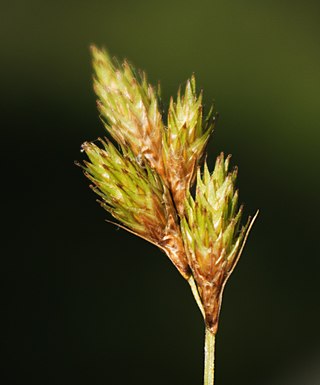
Carex scoparia is a species of sedge known by the common names broom sedge and pointed broom sedge. It should not be confused with the unrelated grass species known as "broom sedge," Andropogon virginicus.

Carex pensylvanica is a species of flowering plant in the sedge family commonly called Pennsylvania sedge. Other common names include early sedge, common oak sedge, and yellow sedge.

Carex bigelowii is a species of sedge known by the common names Bigelow's sedge, Gwanmo sedge, and stiff sedge. It has an Arctic–alpine distribution in Eurasia and North America, and grows up to 50 centimetres (20 in) tall in a variety of habitats.

Carex arctata, known as drooping woodland sedge, is a species of sedge native to eastern North America. It is sometimes called black sedge, compressed sedge, or drooping wood sedge. It occurs from Manitoba to the Maritimes in Canada, south to northwestern North Carolina, and west to Minnesota. Carex arctata grows in bogs, hardwood forests, and spruce forests.

Carex eburnea, known as ivory sedge, ebony sedge, and bristleleaf or bristle-leaved sedge, is a small and slender sedge native to North America, from Alaska and Newfoundland south to central Mexico.


















